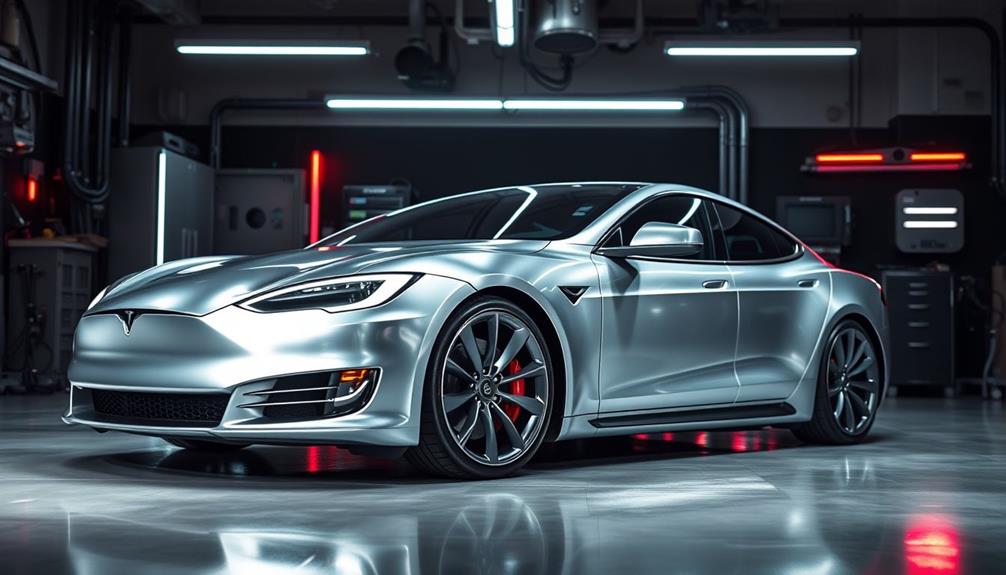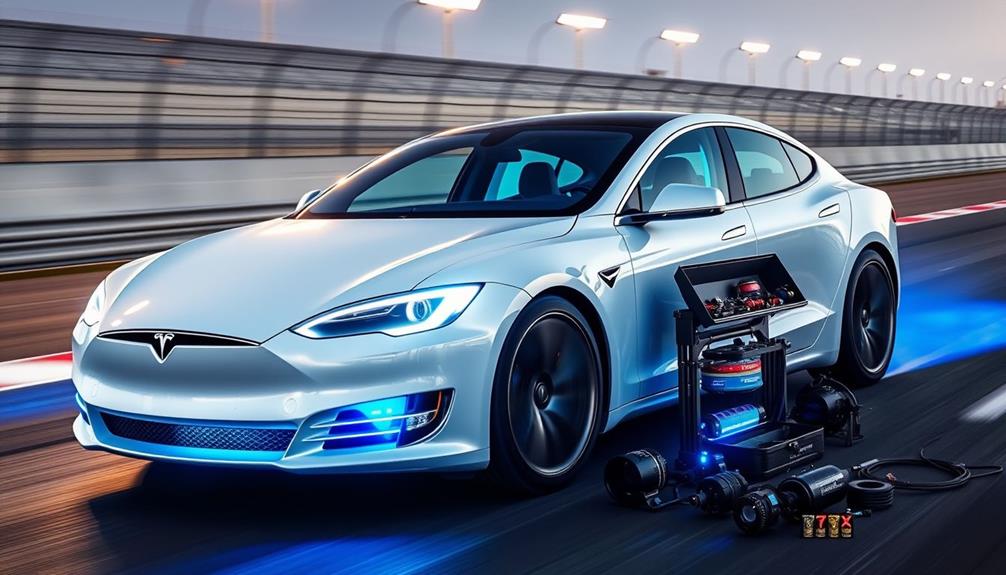Tuning your Tesla Model S Plaid reveals an exhilarating experience, maximizing its impressive 1,020 horsepower. You can adjust speed limits to hit a top speed of 200 mph and activate Drag Strip Mode for jaw-dropping acceleration. Customizing suspension enhances handling, making every corner feel effortless. Software tweaks deliver ideal power delivery, while battery management guarantees peak performance. You can even personalize your driving experience with unique sound profiles. By exploring enthusiasts' insights and modifications, you'll find endless ways to enhance your ride. Discover the exciting possibilities that await you and elevate your Tesla to new heights!
Key Takeaways
- Enable Drag Strip Mode to enhance acceleration, traction, and optimize quarter-mile performance for the Tesla Model S Plaid.
- Adjust speed limits through software modifications to unlock the car's potential top speed of 200 mph.
- Utilize over-the-air updates to continuously improve performance metrics and vehicle safety features.
- Customize suspension tuning for improved cornering stability and handling during high-performance driving.
- Engage with community events and platforms to share insights on performance modifications and tuning best practices.
Overview of Tesla S Plaid
When it comes to electric performance cars, the Tesla Model S Plaid stands out as a remarkable achievement in automotive engineering.
You'll be thrilled to know that it boasts an astonishing 0-60 mph acceleration time of just 2 seconds, making it the fastest production car ever made. With three electric motors generating over 1,000 horsepower, you're looking at a powerhouse that delivers 1,020 horsepower and 1,050 lb-ft of torque.
This incredible performance lets you reach speeds up to 200 mph, although it's currently software-limited to a top speed of 163 mph. The Model S Plaid also shines in the quarter-mile, clocking in the nine-second range, which showcases its exceptional straight-line speed.
Another standout feature is the innovative Yoke steering wheel, which replaces the traditional round design for a more modern, minimalist driving experience.
Coupled with a fully integrated digital dashboard, this setup not only enhances the aesthetic but also provides you with all the essential information at a glance.
If you're looking for a thrilling ride that combines cutting-edge technology with breathtaking speed, the Tesla Model S Plaid is certainly a top contender.
Performance Tuning Options

Exploring performance tuning options for the Tesla Model S Plaid can elevate your driving experience to new heights. With over 1,000 horsepower from its three electric motors, you're already in for a thrill, but tuning can push the limits even further.
| Tuning Option | Benefits | Impact on Performance |
|---|---|---|
| Speed Limit Adjustment | Releases potential 200 mph | Increases top speed |
| Enhanced Drag Strip Mode | Boosts acceleration | Improves quarter mile times |
| Custom Sound Settings | Personalizes driving experience | Adds emotional connection |
| Suspension Tuning | Improves handling | Enhances track performance |
| Battery Optimization | Maximizes power delivery | Extends performance range |
Enhancing Acceleration and Speed
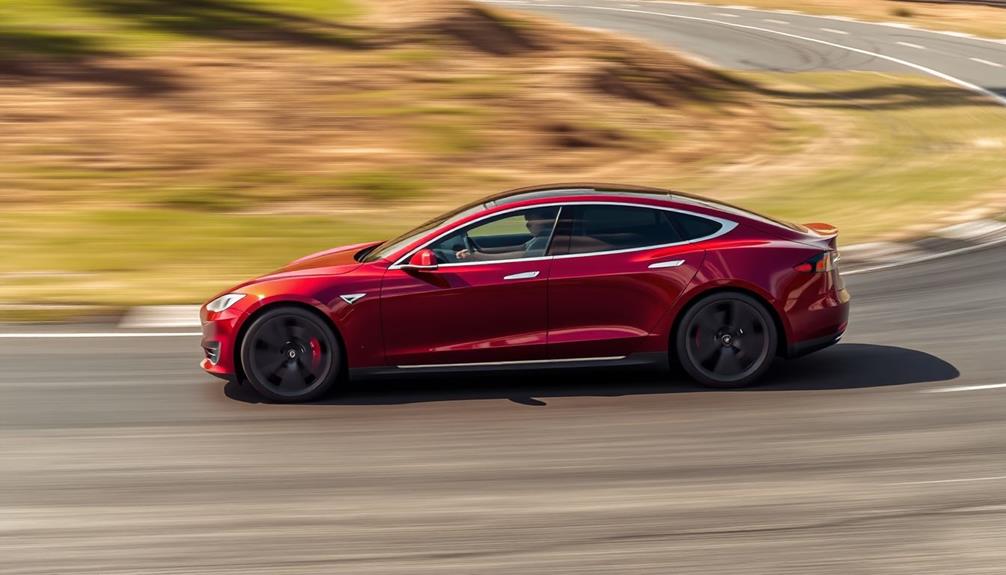
To unfasten the full potential of the Tesla Model S Plaid, enhancing acceleration and speed is key. With its astounding ability to go from 0-60 mph in just 2 seconds, it's no wonder you're enthusiastic to maximize this beast's performance.
The Plaid boasts over 1,000 horsepower and three electric motors, delivering an exhilarating experience that resembles "warp speed."
To truly enhance your acceleration, engage the Drag Strip Mode. This feature lowers the car for improved traction and stability during those high-speed launches, ensuring you get the most out of your vehicle.
While the current software limits the top speed to 163 mph, there's room for future tuning that could release the full potential of 200 mph.
Don't forget about the significant speed increase you feel at 110 mph—this is where tuning options become essential to fully experience the car's capabilities.
Software Modifications and Updates
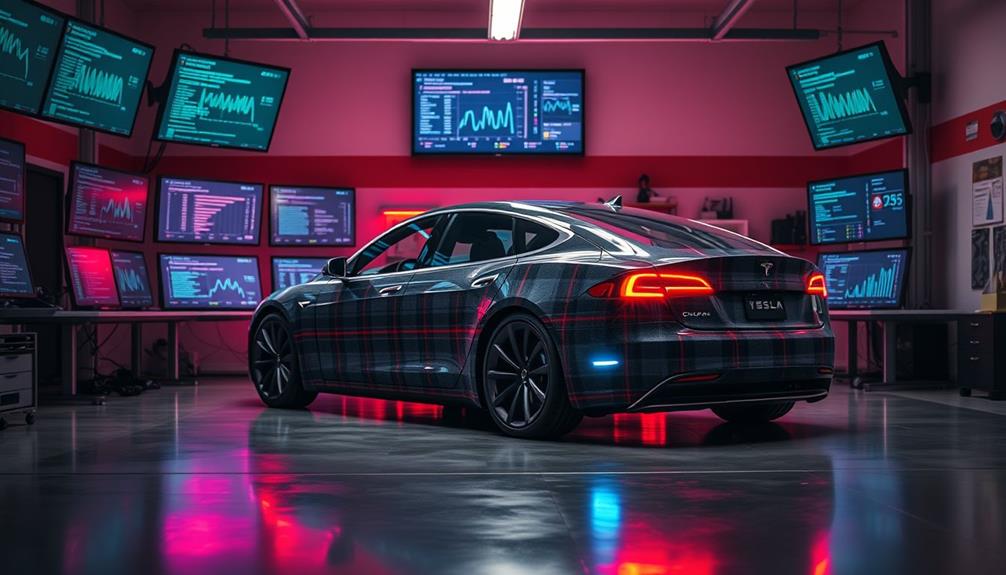
When you consider software modifications for your Tesla Model S Plaid, you're opening the door to significant performance enhancements.
These updates can optimize firmware and release the full potential of your electric motors, pushing your car closer to that exhilarating 200 mph mark.
Performance Enhancement Strategies
Tesla Model S Plaid owners can considerably enhance their vehicle's performance through strategic software modifications and updates. Regular over-the-air updates from Tesla can optimize your car's performance, boosting acceleration and responsiveness to release its impressive 1,020 horsepower and 1,050 lb-ft of torque.
One standout feature is the Drag Strip Mode, which lowers the vehicle for better aerodynamics and traction, allowing you to achieve quarter-mile times in the nine-second range.
You can also take advantage of custom tuning options to modify power delivery settings, further enhancing that exhilarating 0-60 mph capability of under two seconds. Adjustments to torque distribution among the three electric motors not only improve acceleration dynamics but also enhance stability during high-performance driving.
Additionally, regular software modifications refine battery management systems, maximizing efficiency and range when you push your Plaid to its limits.
Remember to check your settings, including the window switch for any specific features that may need activation or adjustment. By staying updated and engaged with your Tesla's software, you can guarantee your Model S Plaid performs at its absolute best.
Firmware Optimization Techniques
Maximizing the performance of your Tesla Model S Plaid goes beyond just tuning; firmware optimization plays an essential role. By regularly implementing firmware updates, you can enhance performance metrics, revealing additional power and improving acceleration times beyond standard specifications.
These updates allow you to adjust the torque distribution among the three electric motors, optimizing traction and stability, especially during rapid acceleration phases.
One of the standout features you'll benefit from is Tesla's Drag Strip Mode, which lowers your car for better aerodynamics and traction. This feature can help you achieve impressive quarter-mile times in the nine-second range.
Additionally, firmware updates refine the vehicle's predictive gear selector system, enhancing driving responsiveness and overall efficiency.
What's great is that you can access these performance enhancements through over-the-air software updates, meaning your Tesla's capabilities can evolve without the need for physical modifications.
Suspension and Handling Improvements
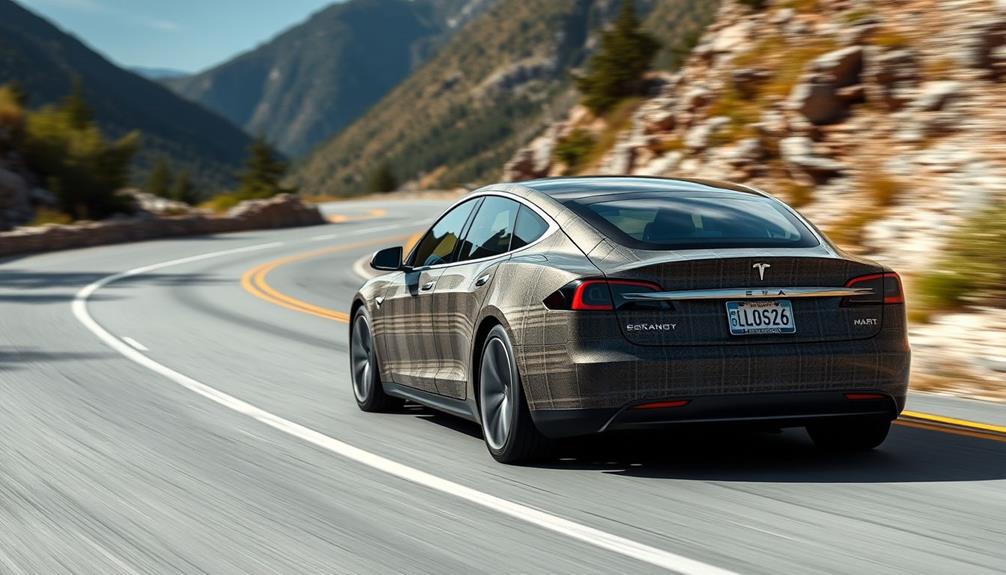
Upgrading the suspension system on the Model S Plaid can greatly enhance your driving experience, particularly when it comes to handling. With over 1,000 horsepower at your disposal, you'll appreciate improved cornering stability and comfort, especially at high speeds.
Consider implementing adjustable coilovers or air suspension to customize your ride height and stiffness settings, optimizing performance for both daily driving and track conditions.
Wider tires are another vital upgrade, as they improve grip and stability during acceleration. Given the car's record-setting 0-60 mph time of just 2 seconds, enhanced traction management is essential.
You'll also benefit from enhanced sway bars, which reduce body roll during dynamic maneuvers, helping maintain composure when maneuvering sharp turns at high speeds—critical for a car that can hit speeds up to 200 mph.
Lastly, utilizing advanced software tuning for the suspension system allows your Model S Plaid to intelligently adapt to road conditions, further improving the overall driving experience and performance metrics.
With these enhancements, you'll reveal the full potential of your Tesla, making every drive exhilarating.
Interior Customization Features

In the Model S Plaid, the interior offers a sleek and modern aesthetic designed for both functionality and comfort.
You'll find a fully redesigned minimalist layout that emphasizes intuitive usability. The central touchscreen acts as your primary control hub, enabling you to customize various settings to create your ideal driving environment.
One standout feature is the climate control screen, which allows you to set precise temperature preferences while also offering innovative modes like Dog Mode and Camp Mode.
These settings guarantee a comfortable atmosphere for passengers or pets during temporary stops.
You can further personalize your experience with the Toy Box feature, where you can access a web browser, play video games, and even upload customizable driving sounds via USB.
The unique Yoke steering mechanism adds to the modern feel, incorporating controls for turn signals and headlights directly into the steering wheel.
In case of a touchscreen failure, a backup gear selector guarantees you're never left without functionality.
The combination of advanced technology and customizable features assures that your driving experience is both enjoyable and tailored to your preferences.
Safety and Reliability Considerations
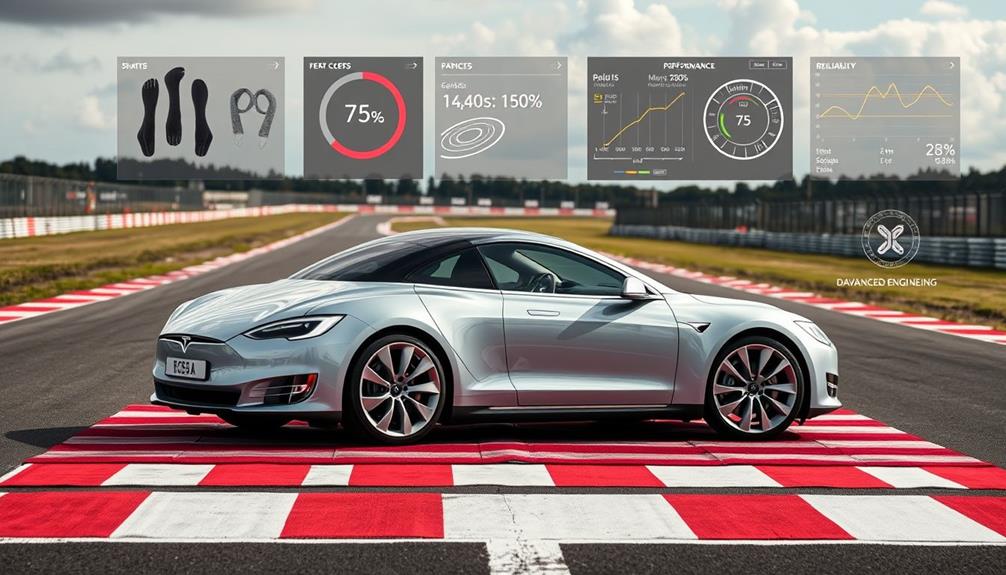
The Tesla Model S Plaid not only excels in interior customization but also prioritizes safety and reliability. This vehicle comes equipped with advanced safety features, including multiple airbags, electronic stability control, and a robust chassis design, all aimed at enhancing occupant protection during high-speed driving.
The National Highway Traffic Safety Administration (NHTSA) has awarded the Model S Plaid high safety ratings, highlighting its impressive crashworthiness and safety performance.
With Tesla's commitment to continuous improvement, the Plaid benefits from regular over-the-air software updates. These updates guarantee that safety features and performance enhancements evolve without the hassle of physical recalls.
Furthermore, Tesla's Autopilot and Full Self-Driving capabilities include numerous safety protocols, such as lane-keeping assistance and collision avoidance systems, which greatly reduce the risk of accidents during operation.
However, while the Model S Plaid shines in safety, some owners have raised concerns regarding build quality, like paint chipping and malfunctioning door handles.
These issues could impact long-term reliability. Balancing its incredible performance with these considerations is crucial for potential buyers, making sure you're fully informed before making a decision.
Community and Enthusiast Insights
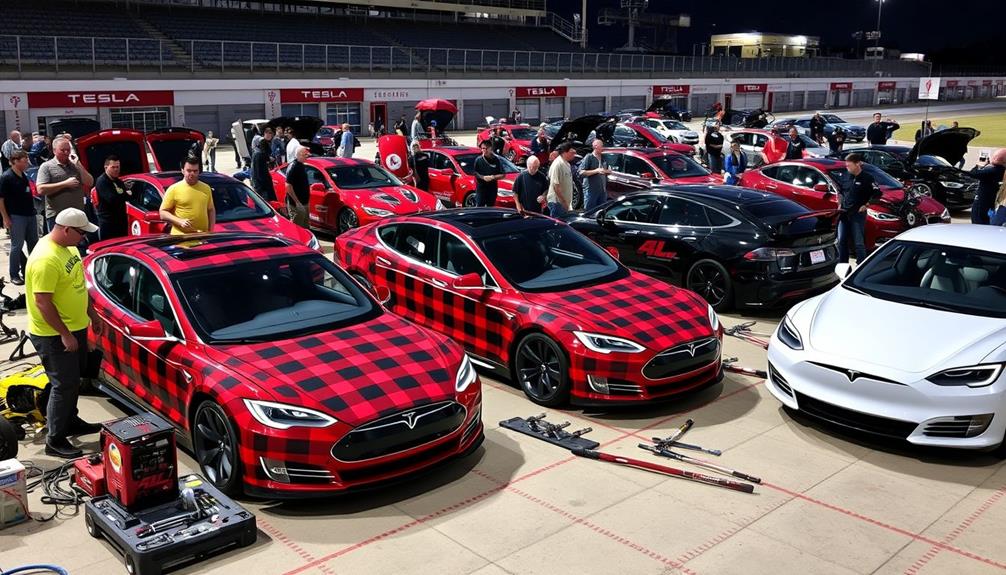
As a Tesla Model S Plaid owner, you're likely part of a vibrant community enthusiastic to share tips on modifications and upgrades.
Whether you're attending tuning events or engaging in online forums, these platforms offer a wealth of performance insights.
Enthusiast Modifications and Upgrades
Many Tesla Model S Plaid owners immerse themselves in enthusiast modifications and upgrades to push their vehicle's performance to new heights.
By focusing on software tuning, you can enhance your Tesla's power, adjusting acceleration and speed limits beyond factory settings. Community insights reveal popular upgrades that improve performance and handling:
- Aftermarket Wheels and Wider Tires: Improve stability and grip during high-speed runs.
- Upgraded Cooling Systems: Prevent overheating during intense driving, ensuring performance integrity.
- Battery Management Software Enhancements: Maximize energy use for sustained high performance.
- Customizable Sound Profiles: Upload unique driving sounds to personalize your experience.
Engaging with fellow enthusiasts on forums often leads to discussions about maximizing drag strip performance.
By utilizing features like Drag Strip Mode, you can lower your car for peak acceleration, achieving impressive quarter-mile times.
As you explore these modifications, you'll find that the Tesla Model S Plaid isn't just a car; it's a canvas for your automotive passion.
With the right tweaks, you can release its full potential and enjoy a driving experience tailored uniquely to you.
Community Tuning Events
Gathering at community tuning events offers Tesla Model S Plaid owners a chance to connect and share their passion for performance.
These events are a goldmine for enthusiasts like you, where knowledgeable participants share insights on software tweaks and modifications aimed at releasing additional horsepower. You'll get to exchange experiences with fellow owners, focusing on maximizing acceleration and achieving faster quarter-mile times.
At these community tuning events, you can showcase your modified Plaid and engage in real-world comparisons of tuning results. It's exciting to see how tweaks can lead to improved 0-60 mph times and enhanced top speeds.
Additionally, the networking opportunities create a collaborative atmosphere, allowing you to discuss potential upgrades, such as tire enhancements for better stability during high-speed runs.
Enthusiast groups often highlight the latest tuning software updates and performance modifications that can be safely applied without voiding warranties. This guarantees you can boost your vehicle's capabilities while maintaining its longevity.
Performance Sharing Platforms
Performance sharing platforms have become essential for Tesla Model S Plaid owners looking to enhance their vehicles' capabilities. These communities provide a space where you can connect with fellow enthusiasts, share tuning experiences, and explore modifications that can push the limits of your already jaw-dropping car.
With a 0-60 mph time of under 2 seconds, the Tesla Model S Plaid is a powerhouse, and many users are keen to access even more potential.
Here are some key insights you might find on these platforms:
- Software tweaks: Learn about optimizing the Plaid's three electric motors for increased horsepower beyond the standard 1,020 hp.
- Tire upgrades: Share recommendations and experiences to improve stability during high-speed runs.
- Suspension tuning: Discover how adjustments can enhance your quarter-mile times, aiming for that elusive nine-second mark.
- Driving mode customization: Exchange tips on maximizing performance in Drag Strip Mode for track days.
These platforms also address quality concerns, offering advice on maintaining your Tesla Model S Plaid's exterior and ensuring its peak performance.
Join in and take your driving experience to the next level!
Frequently Asked Questions
Is the Tesla Model S Plaid the Fastest Production Car?
Yes, the Tesla Model S Plaid is currently the fastest production car, boasting incredible acceleration and unmatched performance metrics. You'll experience its power firsthand, redefining your expectations of speed and electric vehicle capabilities. If you’re looking to push the limits even further, consider exploring Tesla plaid tuning options to unlock its true potential. With the right modifications, you can enhance its already impressive performance and take your driving experience to new heights. Whether you’re seeking more power, better handling, or an overall customized driving experience, Tesla plaid tuning can help you achieve the ultimate driving experience. By investing in a Tesla plaid performance upgrade, you can elevate your driving experience by optimizing key components like the motor, suspension, and battery system. This will not only enhance the car’s acceleration and top speed but also improve its overall handling and efficiency. With a tailored tuning package, you can customize the car to suit your specific driving preferences and enjoy an unparalleled driving experience that truly reflects the pinnacle of electric vehicle engineering.
What Is the Top Speed of the Tesla Plaid Unrestricted?
The Tesla Model S Plaid can reach an impressive top speed of 200 mph when unrestricted. This showcases its incredible engineering, allowing you to experience unmatched acceleration and performance on the open road.
What Makes the Tesla Model S Plaid so Fast?
The Tesla Model S Plaid's exceptional speed comes from its three electric motors, generating over 1,000 horsepower. This power, combined with advanced aerodynamics and wider tires, enables rapid acceleration and unmatched performance on the road.
How Fast Is Tesla Plaid Without Limiters?
Imagine feeling the rush as you push the Tesla Plaid beyond its limits. Without software restrictions, it can soar up to 200 mph, delivering an exhilarating experience that'll leave you breathless and craving more.
Conclusion
In releasing the full potential of your Tesla S Plaid, you're not just enhancing a car; you're elevating your driving experience to exhilarating new heights. With performance tuning and custom features, you can truly make this powerhouse your own. So, why settle for ordinary when you can open extraordinary? Embrace the thrill of the world's fastest production car and join a community of enthusiasts who share your passion for innovation and speed. Your journey starts now!
